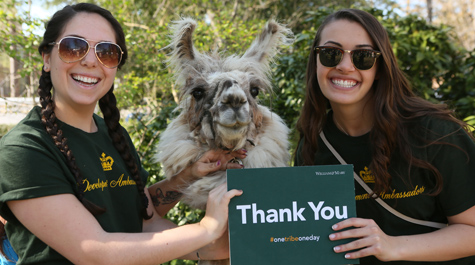$50,000 in matched funds, 750 alumni ambassadors reaching out on social media, 36 cities around the world, seven Netflix-themed videos of College of William and Mary President Taylor Reveley: This year’s One Tribe One Day smashed all the College’s previous single day giving records, racking up 10,358 total donors in just 24 hours.
Tuesday, April 19, the College’s third annual giving day, relied on both in-person alumni gatherings and the internet: for 24 hours alumni, parents, students, faculty, staff and friends made donations of an amount and designation of their choice. Surpassing the initial 7,000-donor goal, the College received a total amount of over $2.19 million within the single day span.
Compared to recent single day giving campaigns at other private universities, the College has pulled ahead: a recent University of Virginia campaign finished with 5,816 donors, Vanderbilt University reached 6,131 givers; Cornell University came the closest, drawing in 10,100 donors.
A component of the day’s success was social media. With a buzz of activity with Twitter hashtags, Facebook posts and Instagram photos, OTOD was successful in engaging the younger generation. As for current undergraduate and graduate students, by the end of the giving day, 840 students gave back to the College.
Secretary of the Board of Visitors Sue Gerdelman ’76 and her husband John Gerdelman ’75 pledged a total of $50,000 to be split up between the top three schools or units that had the most donors during OTOD. In the Gerdelman School and Unit Competition, Arts and Sciences in first place walked home with $25,000, Athletics in second with $15,000, and Student Affairs in third with $10,000.
“It’s important to William and Mary that every person be engaged, every alum feel connected, be engaged with the College,” Gerdelman said. “And so what we say to people and what we mean is that every gift counts, every gift matters and I think most people recognize that William and Mary, its financial resources do not match its academic excellence.”
It’s important to William and Mary that every person be engaged, every alum feel connected, be engaged with the College,” Gerdelman said.
One goal of the annual OTOD campaign was to encourage all types of people to give gifts, regardless of their giving history. To Assistant Vice President for Lifetime Philanthropic Engagement and Annual Giving Dan Frezza, the focus cannot be merely on traditional alumni givers — the College must reach all populations to cultivate an environment of giving.
“The day is about a collective showing of the Tribe and that’s actually the core of why we began the day three years ago,” Frezza said. “The importance of building a culture of engagement and philanthropy dictates that William and Mary must not be a regional institution. We must be an international institution.”
Frezza noted OTOD was not meant just as a competition against other universities.
Nearly one out of five OTOD donors were first-time donors. As the College undertakes the For the Bold: The Campaign for William and Mary challenge to reach a 30 percent undergraduate alumni participation rate by the end of the current fiscal year, new donors are crucial to the College’s success.
Unlike Frezza, Vice President for University Advancement Matthew Lambert ’99, named exactly who the College’s competitors are in terms of alumni participation rates: top private universities.
“This year, if and when we achieve 30 percent participation on our way toward 40 [percent], that will put us ahead of our first Ivy League institution,” Lambert said. “So we’re doing very, very well, and this is another step for us forward in creating a culture of engagement and philanthropy.”
This year, if and when we achieve 30 percent participation on our way toward 40 [percent], that will put us ahead of our first Ivy League institution,” Lambert said.
For the first time in the College’s history, the percentage of state support for the operating budget fell below private philanthropy’s contribution. For Lambert, the College’s future is highly dependent on private support.
Already assessing last week’s event for future OTOD’s, Frezza agreed that one area for improvement was on-campus events. Although the Students for University Advancement held an event on the Sunken Garden, Frezza admitted turnout was low.
“We need to find a way to reach all of our student organizations and get feedback, buy in, but also create an area, message, atmosphere that resonates with our students,” Frezza said. “And I actually believe that the event, even as it was last week, it was just missing the people. I think that goes right back to communication.”

